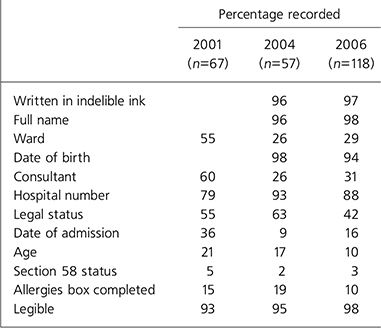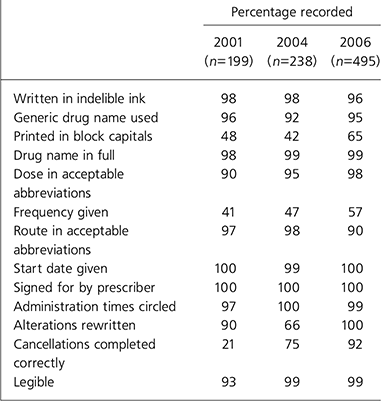Prescription writing is a basic clinical skill for all doctors, but errors in prescriptions are believed to be one of the most common forms of medical error. Prescription errors may lead to harm in a number of ways, including sub-therapeutic dosage, potential overdose or unintended polypharmacy. This type of error may occur for a number of reasons: some relatively complex, such as short-comings in medical training, and others more mundane, such as fatigue, interruptions, or being asked to cover unfamiliar patients (Reference Dean, Barber and ScachterDean et al, 2000). One study of prescriptions in a psychiatric unit for older people found that 20% were illegible and one-third contained missing information (Reference Nirodi and MitchellNirodi & Mitchell, 2002). Clinical audit is a commonly used quality improvement process which measures clinical practice against agreed standards and introduces change where this is indicated (National Institute for Clinical Excellence, 2002). Coventry Teaching Primary Care Trust published guidelines for the completion of prescriptions in May 2001. We used a series of clinical audits in the period June 2001 to February 2006 in an attempt to improve the quality of prescriptions written at the Caludon Centre, a 70-bed in-patient unit in Coventry.
Method
A prospective clinical audit was based on the trust prescription writing guidelines. This was then used by the pharmacist and junior medical staff to conduct three cycles of prospective clinical audit of the prescription records of patients admitted to adult wards at the Caludon Centre. The first audit was completed in June 2001, the second in March 2004 and the third in February 2006. Minor adjustments were made to the audit tool in 2004 and the size of the 2006 audit was increased by the inclusion of a newly opened ward. Results were fed back to trust staff at postgraduate medical education meetings. The pharmacist also conducted regular review of the prescription charts on the wards between the audits and highlighted errors to the appropriate medical team.
Results
A total of 1466 prescriptions on 242 prescription charts were reviewed during the three cycles of audit, 67 records in 2001, 57 in 2004 and 118 in 2006. The recording of patient information on prescription charts improved after the first cycle of audit but declined after the second (Table 1). Although overall legibility improved, the recording of drug allergies, section 58 status and age remained especially poor throughout the audit period.
Table 1. Recording of patient information on drug records

| Percentage recorded | |||
|---|---|---|---|
| 2001 (n=67) | 2004 (n=57) | 2006 (n=118) | |
| Written in indelible ink | 96 | 97 | |
| Full name | 96 | 98 | |
| Ward | 55 | 26 | 29 |
| Date of birth | 98 | 94 | |
| Consultant | 60 | 26 | 31 |
| Hospital number | 79 | 93 | 88 |
| Legal status | 55 | 63 | 42 |
| Date of admission | 36 | 9 | 16 |
| Age | 21 | 17 | 10 |
| Section 58 status | 5 | 2 | 3 |
| Allergies box completed | 15 | 19 | 10 |
| Legible | 93 | 95 | 98 |
The quality of regular prescriptions showed a consistent improvement over the audit period (Table 2). Prescription cancellations improved over the audit period, but the recording of frequency to be given remained poor.
Table 2. Completeness of regular prescriptions

| Percentage recorded | |||
|---|---|---|---|
| 2001 (n=199) | 2004 (n=238) | 2006 (n=495) | |
| Written in indelible ink | 98 | 98 | 96 |
| Generic drug name used | 96 | 92 | 95 |
| Printed in block capitals | 48 | 42 | 65 |
| Drug name in full | 98 | 99 | 99 |
| Dose in acceptable abbreviations | 90 | 95 | 98 |
| Frequency given | 41 | 47 | 57 |
| Route in acceptable abbreviations | 97 | 98 | 90 |
| Start date given | 100 | 99 | 100 |
| Signed for by prescriber | 100 | 100 | 100 |
| Administration times circled | 97 | 100 | 99 |
| Alterations rewritten | 90 | 66 | 100 |
| Cancellations completed correctly | 21 | 75 | 92 |
| Legible | 93 | 99 | 99 |
The overall quality of ‘as required’ prescriptions also showed consistent improvement (Table 3). Recording of reason for administration improved, as did prescription cancellations.
Table 3. Completeness of ‘as required’ prescriptions

| Percentage recorded | |||
|---|---|---|---|
| 2001 (n=119) | 2004 (n=141) | 2006 (n=274) | |
| Written in indelible ink | 93 | 96 | 95 |
| Generic drug name used | 96 | 96 | 96 |
| Printed in block capitals | 53 | 40 | 56 |
| Drug name in full | 99 | 100 | 100 |
| Dose in acceptable abbreviations | 95 | 95 | 99 |
| Frequency given | 87 | 90 | 81 |
| Route in acceptable abbreviations | 94 | 99 | 96 |
| Start date given | 99 | 99 | 99 |
| Signed for by prescriber | 98 | 99 | 100 |
| Reason for administration | 52 | 64 | 74 |
| Alterations rewritten | 93 | 100 | 100 |
| Cancellations completed correctly | 40 | 50 | 73 |
| Legible | 95 | 97 | 100 |
Discussion
The results of this study suggest that clinical audit and feedback combined with pharmacist intervention at ward level can improve the quality of prescriptions in an in-patient setting. The overall legibility of prescriptions reviewed improved to a point where 99.5% of all prescriptions reviewed were considered legible. Specific aspects of prescription writing that had been poor in 2001 also showed improvement, most noticeably the proper cancelling of ‘as required’ and regular prescriptions. However, some basic aspects of prescription writing, such as using block capitals for drug names, only improved slightly and the recording of drug allergies remained very poor throughout the audit period. This is a cause for concern, although the actual risk it represents is difficult to assess. Although drug allergies are believed to occur in 14–17% of all patients, the most common are to antibiotics and non-steroidal anti-inflammatory drugs (Reference Vervloet and DurhamVervloet & Durham, 1998), both of which are not widely prescribed in our unit. However, recording drug allergies remains the responsibility of the prescriber and other audits have shown allergy recording rates of 75% or more are achievable (Reference Tuthill, Wood and CavellTuthill et al, 2004).
Continuous quality assurance requires ongoing data collection, review of that data and action. Various strategies have been suggested to improve the quality and safety of hospital prescribing, including systems analysis (Reference Hronek and BleichHronek & Bleich, 2002), electronic prescribing systems (Reference Fowlie, Bennie and JardineFowlie et al, 2000) and applying human error theory (Reference Dean, Barber and ScachterDean et al, 2000). Barber et al (Reference Barber, Rawlins and Dean Franklin2003) advocate a three-part strategy aimed at reducing prescribing errors. This is based on improving individual prescriber's competence, controlling the prescribing environment and changing organisational culture to allow open discussion of errors. Clinical pharmacists can have a positive impact on prescribing practice, outcomes and resource use (Reference Finley, Crimson and RushFinley et al, 2003), and we believe that clinical pharmacist review on the wards was the most effective element of this audit. Medicines are given because it is believed that the benefits will outweigh any associated risks, but trusts need appropriate controls to ensure that these risks are minimised (Healthcare Commission, 2007). The involvement of clinical pharmacy staff in caring for in-patients is a service that provides such controls and safety measures.
Declaration of interest
None.
Acknowledgements
We thank Drs Padmapriya Musunuri and Karthik Modem for help with data collection.






eLetters
No eLetters have been published for this article.